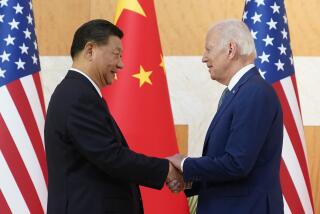Sino-Soviet Summitry
The world may be about to witness the sort of fundamental strategic realignment that happens only once or twice in a generation. Without fanfare, relations between the Soviet Union and China have warmed to the point where the world’s two great communist powers are ready to undertake their first high-level exchanges in decades. If Chinese Foreign Minister Qian Qichen’s trip this week to Moscow turns out as well as expected, it will lay the groundwork for a historic summit meeting between Soviet President Mikhail S. Gorbachev and Deng Xiaoping, China’s senior statesman. In both capitals there is growing confidence that a summit, the first since Nikita S. Khrushchev traveled to Beijing in 1959, will be held next year.
Economic considerations seem to be driving the communist giants toward rapprochement. A reduction of tensions along their 4,000-mile border would allow both nations to concentrate on the economic reforms that top their domestic agendas. Their parallel attempts to invigorate their economies also have made both of them aware of the need for dialogue; they may learn far more from each other about how to jump-start inefficient, centrally planned socialist economies without overheating than they could from the West. Concrete economic gains already are discernible. The Soviets, looking for help in developing the outer reaches of Siberia, have found it in China, which is beginning to supply thousands of contract workers. Cross-border trade, already running at four times the level of a year ago, seems certain to expand.
But both nations also see strategic advantages in dialogue. As relations between Moscow and Washington have warmed, the Chinese have felt left out of deliberations over intermediate nuclear missiles and other matters important to them; the widespread assumption that China belongs in the U.S. camp also troubles the Chinese. Increasingly they have made it clear that they prefer an equidistant relationship with the two superpowers, not a subsidiary role in an anti-Soviet alignment that seems obsolete. The only way for China to strike a more independent stance, the only way for it to achieve the world stature that it regards as its due, is to deal with the Soviets.
The Soviet motivation may be more complex. Ever since Gorbachev listed better ties with China as a priority in his maiden speech as the Soviet leader in March, 1985, it has been apparent that the Soviets want to expand their influence in Asia. Making peace with China would make the Soviets less threatening to their other Asian neighbors and perhaps would increase the pressure on the United States to withdraw its forces from South Korea and the Philippines. A placated China also would allow Moscow to save as much as $1 billion a year in aid to Vietnam. And, for Gorbachev, a summit meeting with Deng would be a personal triumph every bit as sweet as his four meetings with President Reagan.
Deng, too, seems eager for a Sino-Soviet summit to cap his long career. His eagerness has raised the hackles of colleagues in Beijing who are less convinced that Vietnam intends to withdraw its 120,000 occupation troops from Cambodia. Before agreeing to a summit meeting, other Chinese leaders reportedly would like more proof that the Soviets are using their influence on Vietnam to end the Cambodian conflict; a full Vietnamese withdrawal long has been one of China’s preconditions for rapprochement with the Soviets. But Deng, now approaching 85, is apparently not to be denied his summit.
U.S. officials, consigned to the role of spectators as these events unfold, seem confident that American interests won’t be threatened unless the two communist giants forge another military alliance. And that, they say, is still unthinkable, not only because the Chinese are unwilling to jeopardize their new arms links with the United States but also because they regard Soviet technology as inferior. U.S. strategists believe that reduced tensions between China and the Soviet Union may eventually make the whole region more secure. But the Sino-Soviet split has been such a fixture for so long that, once it disappears, other readjustments may be in store.
More to Read
Sign up for Essential California
The most important California stories and recommendations in your inbox every morning.
You may occasionally receive promotional content from the Los Angeles Times.










